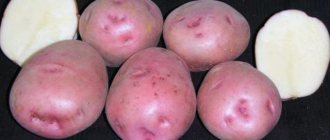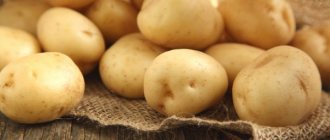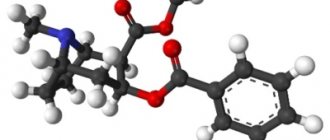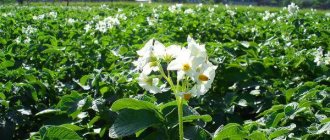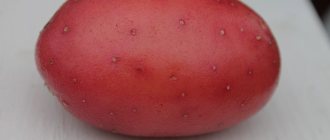Zhuravinka potato is a Belarusian variety of crop that meets all the requirements of world standards. This is confirmed by most reviews from gardeners who grow it. It was entered into the State Register of Russia based on the results of successful tests, which confirmed the declared characteristics of the vegetable. This happened in 2005. Potatoes "Zhuravinka" are recommended for cultivation in the Volga-Vyatka, Central and North-Western regions. But, as practice has shown, it can also be successfully grown in the southern regions.
The keeping quality of the Zhuravinka variety is 96%
Characteristics of the root crop
Zhuravinka is a high-yielding Belarusian mid-late table variety with large tubers. The ripening period is 100-120 days. In 2005, Zhurivinka was included in the register of agricultural crops of Russia.
The potato skin is slightly rough, of medium thickness, and colored in a pronounced red color. The pulp is light yellow. A mesh pattern with low relief is visible on the surface, but in small fruits the pattern is practically invisible. The soil easily moves away from the fruit, which simplifies harvesting, increases shelf life and creates a good appearance.
Small eyes on the surface of the root crop are evenly spaced, have a spherical shape, and are reddish-violet in color at the base. The top is shallow and closed, with a slight hairiness on the surface.
The fruits are egg-shaped (round) or oval, 70-100 mm long. Each nest contains 14-18 potatoes, the maximum number reaches 25 pieces. The weight of the marketable fruit is in the range of 90-160 g. The yield ranges from 178 to 242 c/ha (75 kg/10 sq. m.), which is above average compared to other industrial varieties. Potato marketability is about 90%.
During growth, erect, low, intermediate-type plants are formed. The stem is medium thick, slightly colored with anthocyanin, there are up to six stems on the bush. Small leaves of rich green color with a wavy leaf blade. The inflorescence is medium-sized, small-flowered. The corolla is reddish with purple. The tops grow quite intensively, the shoots are uniform. In terms of tuber formation and the intensity of tuber growth, the variety is classified as average.
The Zhuravinka variety has high taste qualities. Used for the production of starch, chips, crispy potatoes and fries (seasoned with food additives). Ideal for preparing potato pancakes and zraz. When cooked, the fruits are well-cooked, the flesh does not darken, and large grains do not form. Contains 14-19.5% starch.
A positive feature is the significant dormant period of potatoes. Under optimal conditions, it is well stored until summer (keeping quality is 96%).
Description of tubers
- One Zhuravinka potato bush, as mentioned in the descriptions of the variety, produces from 15 to 25 tubers. They come in a variety of varieties, most often oval, but there are also round ones. The length of large specimens is 7-10 cm. The fruits weigh from 90 to 160 g and more. On the smooth, reddish skin of large tubers, a mesh pattern is noticeable. The eyes are deep, evenly scattered on one side of the tuber.
- The medium-thick skin hides juicy yellow-cream flesh. It retains a light shade after peeling and cooking, and boils well. Zhuravinka potato puree has a homogeneous structure, without hard grains.
- The percentage of starch in the pulp is 14-19 units. This indicator provides a high taste characteristic to the Zhuravinka potato variety. Tubers of this variety are suitable for a wide range of culinary products. They are praised for their crunchy properties in the national dish - potato pancakes. Large producers send tons of potatoes to food processing plants to make chips and starch.
Light sprouts
On germinating tubers, small pubescent sprouts of a rich red color with a purple tint form. Their base is round, with a small top.
Landing dates
The quality and quantity of the harvest depends on the time of planting. It is important to monitor the lunar phases, and most importantly, the average daily soil temperature.
If you rush, the tubers will germinate very slowly, and during night frosts (which often happens in early spring in the northern regions of the country), they may die completely. Overexposure to potatoes is no less dangerous; if the soil moisture decreases greatly with the approach of summer heat, the quality of the vegetable’s development will drop significantly.
According to experts, planting potatoes 14 days earlier (later) than the optimal date reduces the yield by 15-20%.
The best conditions for planting the Zhuravinka variety are when the soil warms up to +6...+8 degrees. Doing this at a lower temperature is pointless. In a cold environment, the tubers will simply lie there, and perhaps even begin to rot.
Please note that the indicated temperature is the minimum permissible, the calculation is made for rapid spring warming, and it is achieved at an average daily air temperature of about 15 degrees. And while the soil settles and the roots begin to grow, the average daily indicators will reach the optimal temperature. In the northern regions, you should wait until the soil warms up to +10...+12 degrees.
Care
Unlike many other varieties that grow on their own, Zhuravinka is slightly demanding in this regard. It does not tolerate drought at all. This also applies to high soil moisture. If there is a severe drought and no one waters the potatoes, then the tops will begin to wither ahead of schedule. When the soil is waterlogged, late blight may begin to develop on a bush or fruit. To get a normal harvest, you need to find a middle ground.
It is also worth paying attention to the soil. If it is too saturated with nitrogen, then you should not expect an excellent harvest.
But, despite the fact that the characteristics in terms of care are not encouraging, the variety is still excellent. It tolerates transportation well. It is stored for a long time even in unfavorable conditions.
When fertilizing the soil, loosening it and periodically watering it, Zhuravinka will give one of the best harvests that can be obtained from planting potatoes.
Soil preparation
The composition of the soil directly affects potato yield. The most suitable soil for the Zhuravinka variety will be light sandy loam, peat soil and, of course, black soil. If you have a clayey area with high acidity, add wood ash or compost with sand to it before planting.
Before spring planting, loosen the soil. It is advisable to do this in dry weather. Loosening is carried out to a depth of 12-15 cm. For sandy and sandy loam soils, once is enough, and for clay soils, loosening should be done twice.
Take some wet soil and try to shape it into a cord. Depending on how well this happens, you can determine the composition of the soil:
- sandy loam - a lump is molded, which crumbles when pulled out;
- clayey - rolled into a cord-like strip.
Potatoes should be planted from north to south (northwest to southeast). This scheme will provide illumination of the bushes throughout the day, and shading in the rows will protect against excessive overheating at noon.
The purpose of spring and autumn plowing of the site is to create a well-ventilated layer of soil in which the required amount of moisture will collect and remain. This preparation is extremely important, because no amount of fertilizing or watering can compensate for the lack of oxygen in the over-compacted layer. Also, thanks to plowing, the roots and seeds of weeds are destroyed, and the applied fertilizers are embedded to the required depth. When digging by hand, you should destroy the larvae of the cockchafer and wireworm, and remove the roots of the weeds.
Due to common pests and diseases, it is not recommended to plant Zhuravinka potatoes in an area where other nightshades (tomatoes, eggplants, capsicums) grew last year. A good predecessor would be beets, zucchini, cucumbers, onions, carrots or beans. Experts recommend maintaining crop rotation for 3-4 years.
Features of cultivation
Preparing Zhuravinka potato tubers for planting is no fundamentally different from other varieties. As a rule, a few weeks before planting, tubers are removed from storage, sorted and placed in boxes for vernalization. Since potato varieties resistant to the Colorado potato beetle have not yet been invented, it is possible to treat the tubers with Prestige or Komandor before planting. This will increase the degree of protection of potato plants from Colorado potato and other pests several times. True, protection is usually effective only before flowering; subsequently it will be necessary to treat with any suitable insecticide at least once again.
Any soil is suitable for growing Zhuravinka potatoes, but this variety has a negative attitude towards excess nitrogen fertilizers in the soil, so it is better to underfeed it than to overfeed it.
The Zhuravinka potato grows well only in fully sunny areas. This factor must also be taken into account when choosing a place to plant potatoes.
Due to the large number of tubers in the bush, it is necessary to plant potatoes more sparsely than for other varieties. The row spacing should be at least 60 cm, and it is better to leave 70 cm. In this case, it will be possible to carry out full hilling of the bushes. Their ventilation will increase and each bush will eventually receive more sunlight, which will certainly have a positive effect on the yield. In the case of ordinary thickened planting, Zhuravinka potato bushes will in any case delight you with a large number of tubers. But the size of these tubers will be so small that it would be more rational to use it as animal feed.
The Zhuravinka potato germinates very quickly and is distinguished by powerful and rapid growth of both above-ground and underground parts in the first month of its development. It is during this period, before flowering, that additional moisture is very desirable. And although it tolerates short periods of drought, this cannot but affect the yield.
Interestingly, Zhuravinka potatoes also do not really like high moisture content in the soil. In such conditions, outbreaks of diseases are possible, therefore, if the summer is too rainy, then preventive treatments with fungicides, for example, Fundazol, are necessary.
Fertilizer
One of the most important agricultural practices when growing potatoes is the application of fertilizers, especially in one area without crop rotation. After all, in 3-4 years the soil is depleted, and a meager harvest indicates the need to add nutrients:
- The most accessible fertilizer for residents who use stove heating will be ash. It is rich in phosphorus, potassium, calcium and a number of other useful microelements. Per 100 sq. m contribute about 7 kg.
- Garden fertilizers sold in bags (superphosphate, potassium-magnesium). Apply during spring (pre-planting) plowing to a depth of 12-13 cm. It is extremely important to observe the concentration indicated on the package.
- Compost and rotted manure are among the best nitrogen fertilizers. A well-proven scheme is when 2/3 of the fertilizing is applied during planting, and the remaining 1/3 before the second hilling.
The Zhuravinka potato reacts extremely negatively to the application of fresh (not stored) manure. The fruits may become watery and lose their taste. There is also a risk of infection with late blight and scab.
Approximate rates of fertilizer application per 100 square meters. m:
- Fertile soils. 1.5-2 kg of ammonium nitrate, about 2.5 kg of nitrogen fertilizers, 3.5 kg of phosphorus, 2 kg of potassium and 2 quintals of manure (compost).
- Average fertility. 2.5-3 quintals of manure, 3 kg of nitrogen, 4 kg of phosphorus, 2.5 kg of potassium fertilizers.
- If there is a general lack of organic matter during planting, add a mixture consisting of a hundredweight of humus mixed with 1 kg of ammonium nitrate and 3 kg of superphosphate.
- An increase in yield on any soil will be achieved by adding 5-10 kg of the wood ash already described.
Moderate application of mineral and organic fertilizers has a positive effect on growth. It is not advisable to exceed the standard dose of nitrogen fertilizing. The crane does not tolerate excess moisture, especially during the growing season. Reacts poorly to prolonged soil moisture deficiency.
Recommendations for caring for the variety
The future harvest depends not only on the quality of planting material and correct planting, but also on further care.
Irrigation mode
Zhuravinka potatoes do not tolerate prolonged drought and require moderate regular watering. The amount of irrigation depends on the frequency of precipitation and the condition of the top layer of soil. If there is no rain for a long time, then in the morning or evening the potatoes are watered at the rate of 3-5 liters of water for each bush.
Fertilizers
Zhuravinka potatoes are fed according to the standard scheme: fertilizers are applied twice before and at the time of bud formation, and a third time during the period of active flowering. The following are used as fertilizers:
- urea;
- wood ash;
- superphosphate;
- organic fertilizers.
See also
Description and characteristics of the Yanka potato variety, planting rules and care
Read
It is necessary to strictly follow the recommended dosages and not allow excess nitrogen in the soil, since in this case the potatoes will stop growing and will not form a large number of ovaries.
Hilling up bushes
When the potato bushes reach a height of 15 cm, they should be hilled. A small mound is formed in the near-trunk zone, and the soil is carefully loosened to ensure better air flow to the root system and moisture circulation. The second hilling of Zhuravinka is carried out before flowering begins.
Pest Control
If there are other potato varieties on the site, the Colorado potato beetle is indifferent to the Zhuravinka variety. The crane is characterized by resistance to the golden cyst nematode.
Colorado potato beetle . The presence can be determined by visual inspection of the bush. Young and adult individuals, eating leaves, damage them, as a result of which (due to impaired photosynthesis) the potato does not receive a sufficient amount of necessary substances.
Methods of control and prevention:
- manual collection of larvae and adult beetles;
- the use of chemical and biological drugs (Bitoxibacillin, Tsimbush, Dilor, etc.);
- spray with a suspension: dilute 4 g of wormwood juice in 100 g of water (this is a tincture that is harmless to humans and can be used even before harvesting).
The use of pesticides is carried out no later than 28 days before harvesting potatoes.
Medvedka . The presence of this pest can be determined by its characteristic burrows. Prevention methods:
- when planting potatoes, place coniferous branches, the smell of which repels the mole cricket;
- a soap solution (1 piece of laundry soap dissolved in 50 liters of water) is poured into the holes;
- systematic loosening of 5-6 cm of soil.
Potato nematode . Yellowed leaves of a vegetable indicate the presence of this pest. It cannot be treated. To destroy the spread, dig up the bush along with a lump of earth and burn it.
Wireworm . Often, this pest does not cause widespread damage. However, affected fruits rot and damaged stems may turn black. For destruction, pesticides of general influence are used (for example, Anometrine).
History of the variety's creation
This potato was created in collaboration between breeders from Belarus and farmers from Russia - from the Niva farm at the beginning of this century. Zhuravinka potatoes were included in the Russian State Register in 2005. The patent was registered at the Republican Unitary Enterprise Scientific and Practical Center of the National Academy of Sciences of Belarus for potato and horticulture.
This potato variety is recommended for cultivation throughout almost the entire territory of Russia - in the Volga-Vyatka, North-Western, Central and Central Black Earth regions.
Description of Belarusian potatoes Zhuravinka - video
Disease Control
Potato variety Zhuravinka demonstrates resistance to potato canker (pathotype I), blackleg, common scab and viruses X, S, M. The variety's resistance to diseases such as rhizoctonia, late blight of foliage and root crops, viruses Y and L is average.
Late blight. Identified by dark spots on the leaves. From below they acquire a yellowish coating. In the fight against this disease, the most effective method has proven to be spraying bushes with a solution of copper sulfate (15 g per 12 liters of water) and Bordeaux mixture.
Common scab. A peculiar fungus that directly covers the fruit. Attacks tuber buds. It can only be discovered by digging up the potatoes. In case of active progression of the disease, the area should be sprayed with the toxic chemical TMTD (5 g of product per 10 liters of water).
Fungal diseases, as a rule, do not have a significant negative effect on potatoes. Most of them can be prevented by following proper planting and careful harvesting of vegetables.
Pests and diseases
Potatoes "Zhuravinka" have high natural immunity, and therefore are immune to most common diseases.
Among them:
- potato cancer;
- common scab;
- blackleg;
- viruses X, C, M.
If the growing conditions are inappropriate, “Crane” may suffer from late blight, rhizoctonia and viruses Y, L. The lesion can be identified by the presence of yellow spots on the leaves, blackening shoots at the base and rotting tubers. Therefore, in order not to encounter these problems, you should apply preventive treatment of bushes 2-3 times per season.
"Crane" is not susceptible to attack by the golden nematode. It also exhibits average resistance to the Colorado potato beetle. When it spreads massively, the bushes of this potato variety are the last to be affected.
How to store Zhuravinka potatoes?
Growing an excellent harvest is not easy, but it is also important to preserve it without loss, and this is a whole science. Success depends on many factors:
- temperature regime;
- humidity;
- presence of damage to fruits;
- keeping quality of the variety.
Therefore, all tubers that you are going to store must be:
- whole;
- dry;
- mature;
- healthy;
- without the presence of sprouts;
- clean.
The entire storage period for potatoes consists of several conventional stages:
- Medicinal. Provides for drying, ripening, healing. After digging, the potatoes are left in bulk for 1.5-2 hours to dry. Then move the harvest under a canopy, where it will lie for about 14 days. At this time, the potatoes “breathe”, releasing moisture and heat, which contributes to the formation of dry skin on the damage. This process will protect the fruits from harmful microorganisms.
- Cooling. Provides for a gradual decrease in the temperature of the tubers to +2…+4 degrees. It is highly advisable to do this gradually. When the specified temperature is reached, biological and physiological processes freeze inside the fruit.
From the moment of digging until storing potatoes, you must not wet or wash them. It should be protected from contact with dew or rain.
- Basic. Includes compliance with recommendations for direct storage of potatoes: The fruits must be kept in complete darkness, otherwise they will become unsuitable for consumption.
- The best storage temperature for the Zhuravinka variety is within +2…+4 degrees. At a higher level, the tubers germinate; at a lower level, they deteriorate. You can lower the temperature in the basement by opening the vents. If storing Crane in a pantry drawer, use plastic bottles filled with ice.
- Humidity in the room should be between 85-90%. If the air is more humid, it will cause sprouts to form or cause rot. In dry storage conditions, potatoes will lose water and become soft and flabby.
You can store Zhuravinka potatoes in several ways:
- In bulk in the basement (cellar). It is advisable to resort to this method with a small amount of potatoes, because just a couple of spots of rot will be enough to destroy the entire harvest.
- In containers. An ideal way for farmers who are going to sell their crops. Such special containers are designed for 0.5 tons of potatoes, have holes for ventilation and can be located in several rows in height.
- Quite often they resort to storage in bags made of natural materials. This method allows you to store potatoes in several rows, and is also convenient due to the fact that the vegetables are divided into small portions - this does not interfere with air exchange.
- For small storage volumes, storage in boxes is most suitable. It is better to use coniferous wood, as they prevent the development of fungi and harmful bacteria. Due to convenience, plastic containers are also used.
Plants that secrete phytoncides (fresh rowan leaves, pine or spruce branches) will help preserve potatoes longer.
Harvest and storage
To preserve the harvest as much as possible, Zhuravinka potatoes should be harvested on time. As a rule, vegetable harvesting begins after the tops of the plant fall off, which occurs on the 20th of August.
After collecting the tubers, they are laid out on a flat surface, preferably with little access to sunlight, in a spacious place, so that they dry. And only then the potatoes are put into the cellar in boxes or in a bag. Before harvesting the crop in a street hole, it is recommended to pre-disassemble the tubers into seed potatoes and small things. The last group also includes tubers that are bad or pierced as a result of digging.
Important! Potatoes should be harvested in dry weather, and the crop should be stored only in a ventilated cellar.
Reviews
★★★★★
Vasilisa, 48 years old. The whole family loves Crane.
Children say that these are potatoes for the lazy - mashed potatoes are prepared very quickly. This variety is easy to plant and care for and can be stored for a long time without problems. ★★★★★
Irina, 29 years old. Zhuravinka has an excellent taste.
Potatoes are easy to care for. When they first started planting, the yield was high, but then for some reason it dropped sharply. ★★★★★
Alexander, 36 years old. I never really planted potatoes, but I took 10 Zhuravinkas for testing.
I collected as many as 4 buckets of large, good potatoes. And Zhuravinka’s taste is delicious. I'll definitely plant it again next year. Hide
Add your review
Zhuravinka potatoes, due to their unpretentiousness and high taste, are gaining popularity every year. Growing this variety is not difficult, the main thing is to adhere to optimal watering and other care requirements, and a high yield is guaranteed.
0
0
Copy link
Advantages and disadvantages
Zhuravinka potatoes have a number of advantages. Among the main ones it is worth noting:
- Excellent taste.
- High and stable yield.
- Excellent keeping quality.
- Not afraid of long-term transportation over long distances.
- Quite high immunity that protects the crop from fungal diseases.
Along with this, there are several disadvantages:
- This is not the most dietary variety. Therefore, Zhuravinka diet is not suitable for people practicing the Zhuravinka diet.
- Slowly ripens.
Advice from experienced gardeners and reviews about the Zhuravinka variety
Many summer residents advise digging up the area in the fall and adding a bucket of rotted manure, 10 g of “Superphosphate” and a glass of wood ash - the dosage per 1 m² of area. In spring, the land is plowed again, but without fertilizers.
To combat Colorado potato beetles, fragrant plants are planted next to potato bushes.
Reviews about the Zhuravinka variety are mostly good. Many people like the taste and abundant harvest. However, summer residents note that potatoes require care. Gardeners sometimes call this potato variety Zhuravushka.
Vasily, Perm: “I planted this variety on my plot and began to notice that it was rather capricious to care for. In order for the bushes to grow well, it was necessary to fertilize with minerals and organic matter several times. However, it tastes good.”
Natalya, Moscow: “I want to note the excellent taste of Zhuravushka potatoes. Children adore her. The puree is prepared without unnecessary manipulations, it turns out without lumps and has the perfect color.”
Lida, Barnaul: “The variety turned out to be very productive. I came across him by accident. I read a description of the Zhuravinka potato variety on the Internet and saw a photo of the harvest. Compared to other varieties, Zhuravinka has the most tubers per bush.”


